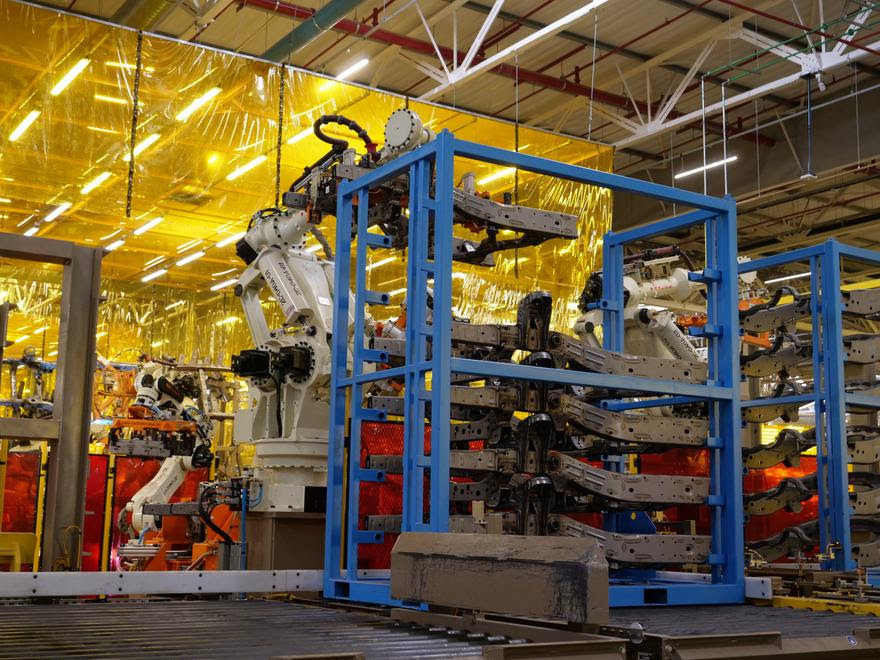Product of the Day
Ford completes high-tech plant to make new Ranger
The only Ford-owned and operated frame plant in the world, in the Tshwane Automotive Special Economic Zone, is part of a R15-billion investment
Share
- Click to share on X (Opens in new window) X
- Click to share on Facebook (Opens in new window) Facebook
- Click to share on LinkedIn (Opens in new window) LinkedIn
- Click to email a link to a friend (Opens in new window) Email
- Click to share on Reddit (Opens in new window) Reddit
- Click to share on WhatsApp (Opens in new window) WhatsApp
- Click to share on Pinterest (Opens in new window) Pinterest
A new Ford facility near Tshwane uses 585 robots and more than 1,000 tools in a highly automated frame welding and assembly process. The final and largest piece of Ford Motor Company’s R15.8-billion investment puzzle for its South African operations, it introduces a new Frame Line, which is commencing operations in preparation for production of the next-generation Ranger.
Located in the Tshwane Automotive Special Economic Zone (TASEZ) adjacent to Ford’s Silverton Assembly Plant, the Frame Line is the only Ford-owned and operated chassis manufacturing facility in the world. It measures a vast 100,000m2 and boasts the most advanced robotic manufacturing and quality control systems currently available.
“Our objective with the next-gen Ranger is to achieve the highest-ever production volumes and quality for the Silverton Assembly Plant, ensuring that the vehicles we deliver to our customers in South Africa and in more than 100 global export markets are world-class in every sense,” says Ockert Berry, VP of operations at Ford South Africa.
“The ladder-frame chassis of the Ranger pick-up is fundamental to its overall quality, performance and durability, whether used as an everyday family vehicle or in hard-working commercial applications. Accordingly, as with our new on-site stamping plant, bringing the manufacturing of the frame in-house allows us to carefully monitor and control every step of the production process.
“We invested in the latest robotic technologies for the welding and handling of the frame components, along with a fully automated e-coat system and robotic wax application. Rigorous quality checks are performed, using advanced inspection and measurement systems, including the sophisticated three-dimensional blue light scanner system, to ensure that there are no compromises in quality.”
At the heart of the Frame Line are two identical lines that manufacture these large and heavy steel components, with 15 derivatives produced to support the various model iterations, as well as the local and export market requirements. A total of 387 hourly employees and 25 salaried staff run the Frame Line in a two-shift operating pattern – all of whom have undergone extensive in-plant training.
“The facility is 95-percent automated, relying on 585 robots to assemble and weld the frames,” says Yetheen Gengan, area manager for the Frame Line. “We use the latest SKS automated intelligent welding system with I&K Pulse technology to guarantee the highest level of precision welding and consistency.
“Additionally, we have more than 1 000 tools on the lines, which includes buffers and robot grippers, resulting in a seamless production process that eliminates manual handling and operations that could introduce variances in manufacturing quality.”
Alongside the production area is a sophisticated multi-stage e-coat facility where the frames are completely immersed in a range of cleaning and phosphate solutions, before being submerged in an electrically charged tank where the paint is uniformly bonded to the metal. Thereafter a robotic station applies a protective wax inside the frame to provide rust protection and durability.
Rigorous quality control measures are implemented throughout the Frame Line, including in-line Perceptron measurement of every chassis produced in the plant. Furthermore, the high-tech GOM ATOS ScanBox blue light scanner system is used to create highly detailed 3D models of the entire chassis or individual sections, with the results compared to a stored design specification.
“With these advanced and extremely accurate measurement and scanning systems we are able to track real-time data to quickly identify and address any quality issues before the frame leaves the plant,” Gengan says. “All of the data is stored in our quality management system to monitor trends, and we can access the measurements and imaging data at any point should a concern be raised on any chassis we produced.”
As part of the extensive quality checks, the plant also incorporates a weld tear-down facility with world-class macro cutting and etching processes that assess the strength and integrity of the individual welds.
Once the frames are completed, they are stored in a below-ground finished goods area with a storage capacity for 6 000 units. Thereafter the frames are processed through an automated sequencing facility and moved across to the Silverton Assembly Plant where the suspension and brake components, differentials, engine, gearbox, exhaust and fuel tank are fitted in sub-assembly areas before being mated with the cab and load box on the Trim, Chassis and Final line.
Says Berry: “Having the Frame Line located right next door to the assembly plant is immensely advantageous, as it not only ensures that the frames are sequenced onto the assembly line in the most efficient manner, but it also eliminates the damage incurred when handling and transporting the parts by road. All of this contributes to improved quality and greater customer satisfaction.”
Share
- Click to share on X (Opens in new window) X
- Click to share on Facebook (Opens in new window) Facebook
- Click to share on LinkedIn (Opens in new window) LinkedIn
- Click to email a link to a friend (Opens in new window) Email
- Click to share on Reddit (Opens in new window) Reddit
- Click to share on WhatsApp (Opens in new window) WhatsApp
- Click to share on Pinterest (Opens in new window) Pinterest
| Thank you for Signing Up |



















